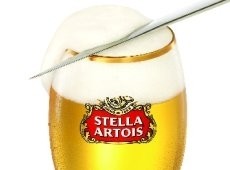Stella Artois: be a master of your trade

The new Stella Artois Draught Master training programme is about more than just teaching you how to pour a perfect pint. Ewan Turney finds out how beer category knowledge and selling Stella with cheese can boost business.
Beer sommelier Marc Stroobandt makes some serious promises at the start of the Stella Artois Quality Training Programme day, which he hosts. "I can show you things with beer that you never imagined," he tells the 100 bar staff present. "I will show you how to get more people in your pub and how to sell more beer and more food. It is all about selling."
The Stella Artois Quality Training Programme is a new on-trade training scheme, which has been launched as part of the Draught Master initiative. It is designed to ramp up product and category knowledge and provide bar staff across the country with the tools to pour a perfect pint every time.
Think more like a chef
The first goal of the training is to increase the depth of knowledge to provide a base for selling more beer. Stroobandt advises staff they must act more like chefs with food when it comes to selling. The first job of the day must be to go and check the cellar to see which beers need shifting. If the beer has been on for two days, you need to sell it. In a similar way to chefs putting specials on, advise the rest of the team to steer people towards a particular beer.
Customers have a moment when they pause at the bar before ordering and that provides the perfect time to jump in and sell them a particular beer. Ask customers what type they are looking for. Something light and refreshing? Sell them a Pilsner. Something heavier and more comforting? Then an ale is in order.
But be canny. For example, if you need to shift your Staropramen, you can suggest it as an alternative to Beck's Vier, as it is the same style.
The other key question is about who takes care of quality control. How do you find out if the beer is good quality? "If you let the customer tell you the beer is bad, it is too late," says Stroobandt. "Check your beers every morning or even when your customers are in. It will get them talking and reassure them you are on top of quality."
Stroobandt's pet hate is staff telling customers "we don't stock that". Always suggest an alternative and knowing your beer styles and taste profiles really helps with this, he advises. He wants to see lagers adopt a similar scheme to the Cyclops tasting guide seen on ales, which gives staff and customers pointers on what beers taste like.
It's all about the service
Matching beer and food helps elevate beer sales. Stroobandt suggests using the time it takes to pour a pint to tell customers about the day's specials. And when food is delivered to tables, ask if diners want a refill of their beer — they are unlikely to get up and go to the bar after food arrives.
Staff are advised on beer and food matches, such as Stella Artois and cheese, and spicy food with Pilsner lagers, such as Beck's Vier.
All venues who sent staff to the training course will be assessed by Cask Marque inspectors and the best will move forward to the UK National Draught Master event on 13 October.
The national winner will represent the country at the World Draught Master event, which will be held in London on 28 October.
Stella Artois training kits will be made available to licensed premises, including training materials, skimmers, coasters and drip catchers. The training initiative will be followed with Cask Marque certification and training support.
Perfect pour
Staff are taken through the nine stages for the perfect pour of Stella Artois:
1. The purification: Use a clean, rinsed branded glass.
2. The sacrifice: Open the tap in one quick action and let the first drops of beer flow away.
3. The liquid alchemy begins: Hold the glass just under the tap without touching it at a 45° angle.
4. The head: Lower the glass to allow the natural formation of the foam head.
5. The removal: Close the tap quickly and move the glass away so beer doesn't drip into the glass.
6. The beheading: While the head foams up and flows over the side of the glass, smooth it gently with a head cutter.
7. The judgment: The right amount of foam is usually about two fingers thick.
8. The cleansing: Clean the bottom and sides of the glass.
9. The bestowal: Present the beer on a clean beer coaster with the logo facing the consumer.











